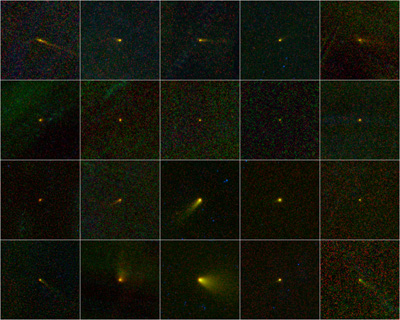
NASA's WISE mapped the night sky in infrared light, resulting in the discovery of a myriad of new astronomical objects and bodies. More appropriately named the Wide-field Infrared Survey Explorer, WISE's one-year mission has turned up these twenty comets: as NASA calls it a 'family portrait.' Although this picture (or pictures) aren't in the clearest resolution (they were taken in infrared), the backgrounds are a bit fuzzy due to random fluctuations in infrared light (which is dust in out solar system). You can't see stars because "they were subtracted during the process of combining multiple WISE pictures to make this view centered on the moving comets." NASA writes.
According to the WISE multimedia gallery: "Comets are named by the International Astronomical Union’s Minor Planet Center, and the names indicate the circumstances of discovery. The designations of the comets in the collage, from left to right, top to bottom are: 237P/LINEAR (2002 LN13), 233P/La Sagra (2009 WJ50), P/2009 WX51 (Catalina), P/2010 B2 (WISE), P/2010 D1 (WISE), P/2010 D2 (WISE), C/2010 D3 (WISE), C/2010 D4 (WISE), C/2010 DG56 (WISE), C/2010 E3 (WISE), C/2010 FB87 (WISE-Garradd), C/2010 G3 (WISE), C/2010 J4 (WISE), P/2010 K2 (WISE), C/2010 KW7 (WISE), 245P/WISE (2010 L1), C/2010 L4 (WISE), C/2010 L5 (WISE), P/2010 N1 (WISE), and P/2010 P4 (WISE), Click the link on each name to see information about each comet at the JPL Small-Body Database Browser, including a 3D representation of their orbits"
If you would like to learn more about the WISE mission, you can see them at their website, along with many other pictures and more.
Image Credit: NASA/JPL-Caltech/UCLA
http://wise.ssl.berkeley.edu/

No comments:
Post a Comment